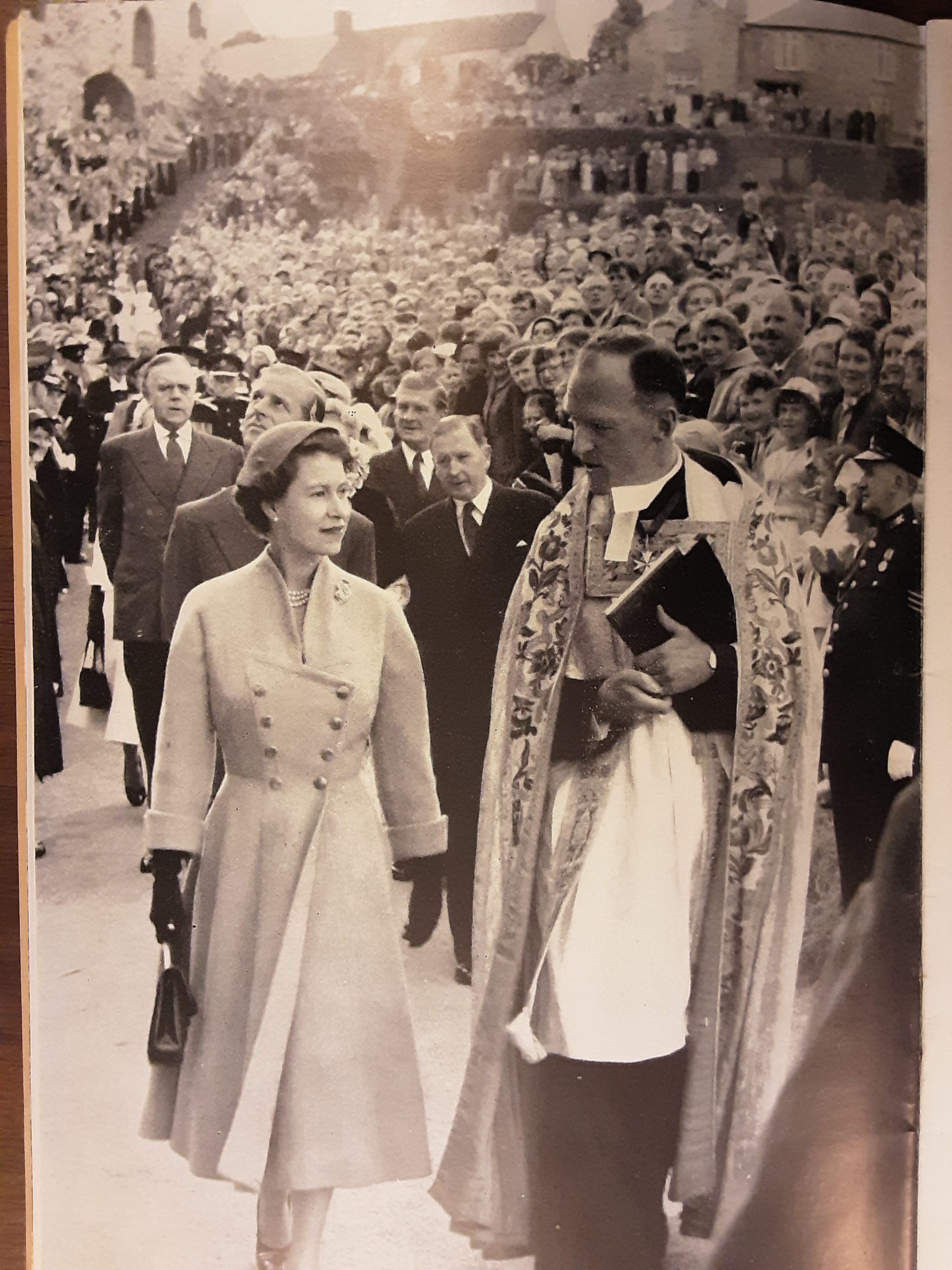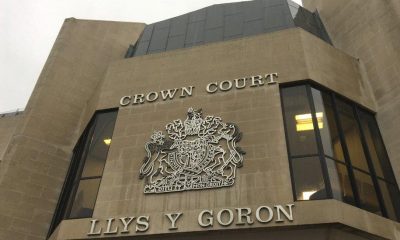News
The Queen in Pembrokeshire

OVER the course of her long reign, it would be a stretch to say Queen Elizabeth II was a regular visitor to Pembrokeshire.
However, from her first official visit in 1955 to her final one in 2014, she would see how Pembrokeshire changed over the decades.
When she arrived at the River Cleddau on the Royal Yacht Britannia in 1955, the waterway looked much different than it does today.
When the royal children Charles and Anne disembarked to visit the beach at Lindsway Bay, they enjoyed a different view than modern visitors.
Instead of refineries, the relics of Second World War radar and aircraft stations fringed the estuary, and farmland sloped down to the river on either side.
The Royal Dockyard at Pembroke Dock closed in 1926 but still housed 210 Squadron of the RAF and the iconic Sunderland aeroplanes, a legacy of the War when the town was home to the largest operational base for flying boats in the world.
Pembrokeshire’s population fell after the War. The economy was still rural, and there was little heavy industry. The main towns retained their historical character, still littered with evidence of some’s medieval origins and their nineteenth-century expansion.
During the three-day visit, apart from Pembroke Dock, the Queen visited Dale, Neyland, Haverfordwest, Pembroke, and the cathedral city of St Davids.
When the Queen and Prince Philip returned to Pembrokeshire three years later, the Haven’s age of oil was just starting.
The coming of modern industry would change Pembrokeshire forever.
In 1960, Prince Philip attended the official opening of the ESSO refinery; within five years, the Regent refinery was online.
By the time of the Queen’s next official visit in 1968, the Haven would be much changed.
Construction of the “new” Pembroke Power Station was well underway. Her Majesty toured the new, state-of-the-art Gulf Refinery.
When she returned nine years later to mark her silver jubilee, Pembrokeshire’s oil industry was already at the start of its long and slow decline.
On June 7, the County’s streets thronged with people celebrating the Silver Jubilee at street parties that sometimes stretched long into the evening.
During the gloriously sunny weather that accompanied her visit on June 23, the Queen travelled to Milford Haven and Haverfordwest while crowds filled the streets as the royal motorcade whisked her through Pembroke Dock en route to the County’s two largest towns.

Well-wishers packed Haverfordwest’s High Street fifteen-deep on either side as the royal party visited the town’s Shire Hall.
During her visit to Milford Haven the same day, the royal party could reflect on how the town had rapidly expanded as industry overtook the town’s fishing industry.
By 1982, the old certainties had faded further.
The early 1980s recession hit Pembrokeshire hard. While the revamp of the now-Texaco refinery provided short-term relief from the oil industry’s decline, the County the Queen visited in 1982 was in a worse economic situation than it had been since the 1950s.
Even during the salad days of refinery building, unemployment remained stubbornly above the national average. Now, Pembrokeshire was under the cosh.
Crowds still turned out in large numbers on Haverfordwest High Street as the Queen strolled down it flanked by flagbearers from the Royal British Legion.
The 1982 visit was particularly notable for being the first time the Queen awarded the traditional Maundy Money in Wales.
The BBC broadcast the ancient ceremony live from St Davids Cathedral, where the city centre and cathedral close were packed with onlookers trying to get a glimpse of the monarch.
The broadcast can still be viewed on YouTube. While the commentary borders on the comically reverent, the public’s enthusiasm remains clear.
In 1995, the Queen arrived in Solva on the Royal Yacht Britannia, having sailed from Cornwall.
During her visit, she re-conferred the city status on St Davids it had lost in 1886.
The trip was planned months in advance, and the visit’s purpose was its ceremonial aspect.
However, the Queen changed the programme to travel to Haverfordwest and meet the wives and children of five servicemen from the Royal Welch Fusiliers (based at Brawdy and of which she was Colonel-in-Chief) held hostage in Bosnia during the Balkan wars.
The tone of the coverage is markedly less reverential than thirteen years before, and the vox pops notably less strained and affected in tone.
In 2001, the Queen and The Duke of Edinburgh arrived at Haverfordwest Station. They travelled to St David’s Cathedral to open the restored Porth-y-Twr (gatehouse).
In the afternoon, she opened County Hall, Haverfordwest, and later visited Pembroke Dock Community School and officially opened it.
Afterwards, the Queen and The Duke of Edinburgh attended a Garden Party at Pembroke Castle before being whisked off to the next round of royal engagements.
In 2014, and always a keen horsewoman, The Queen visited Cotts Farm Equine Hospital at Robeston Wathen, where she was greeted by Narberth Scouts, before heading to one of Pembrokeshire’s business success stories at Prince’s Gate, Tavernspite, where she witnessed the production of the spring water that made the company’s name in the company of children from Tavernspite and Templeton schools.
The Queen and Prince Philip ate lunch at Picton Castle before heading to Pembroke Dock, her first landing point in Pembrokeshire almost sixty years before.
Having lived through so much of history, the Queen’s return to the town book-ended her visits to our County.
In 1955, Pembrokeshire was still emerging from the end of the Second World War.
Her Majesty saw the tail end of the County’s military connections and the dawning of industry.
Returning in 2014, she opened a heritage centre which memorialises the past through which she lived and saw the beginnings of a new economic direction for the County as it looked to the sea and tide for energy instead of oil.
From pastoral to industrial and post-industrial, ceremonial to personal to embodying a living heritage, the Queen saw Pembrokeshire over seven decades.
And those who saw her while she was here won’t forget their experiences.
Crime
Emergency bags rolled out to support domestic abuse victims across Dyfed-Powys

Thirty packs provide immediate help for families fleeing dangerous situations
A NEW initiative aimed at supporting victims of domestic abuse has seen thirty emergency bags distributed for use across the Dyfed-Powys Police area.
The bags, which contain essential items including toiletries, non-perishable snacks and emergency supplies, are designed to offer immediate practical support to individuals and families forced to flee abusive situations, often with little or nothing.
The scheme forms part of the Police and Crime Commissioner’s wider commitment to improving outcomes for victims and is being delivered in partnership with Dyfed-Powys Police and Dal i Godi, the commissioned Independent Domestic Violence Adviser (IDVA) service.
Dal i Godi provides specialist support to victims at high risk of serious harm, including safety planning and advocacy through the criminal justice process.
Police and Crime Commissioner Dafydd Llywelyn said the initiative was already proving its value.
“This is an incredible initiative that I’m proud to support,” he said. “It provides meaningful help to those experiencing trauma and reflects our ongoing work to put victims first.
“Within just a few days of the bags being distributed to the Dal i Godi service, one was given to a victim fleeing a domestic abuse situation, along with a children’s pack to support their young family. That shows just how essential this support can be and how quickly it can make a difference.”
Detective Chief Inspector Llyr Williams, from the Dyfed-Powys Police Vulnerability Hub, said the emergency bags could provide a vital lifeline at critical moments.
“These emergency bags offer support at some of the most difficult moments in a person’s life,” he said.
“The contents provide immediate comfort, dignity and practical help for those leaving their homes in crisis. While simple, they represent an important first step towards safety and recovery.
“We are proud to be working with partners across the Dyfed-Powys area to ensure this support reaches people when they need it most.”
Anyone experiencing domestic abuse, or concerned about someone else, is encouraged to seek help. In an emergency, call 999.
Domestic abuse can also be reported online via Dyfed-Powys Police.
Support services available include Victim Support Dyfed-Powys, which offers free and confidential help to anyone affected by crime, whether or not it has been reported, and Dal i Godi, which provides specialist IDVA support for high-risk victims.
The Live Fear Free Helpline offers 24-hour support for those experiencing domestic abuse or sexual violence across Wales.
If you or someone you know is a victim of domestic abuse, please consider reporting it. If you are in danger or need support right away, please call 999.
You can report domestic abuse through the online crime reporting service here: Report domestic abuse | Dyfed-Powys Police.
Support is also available via the below support services:
Victim Support Dyfed-Powys
Free, independent support for anyone affected by crime in the Dyfed-Powys area, whether or not it has been reported to the police.
0300 123 2996
Dal i Godi (IDVA Service)
Specialist support for victims of domestic abuse at high risk, offering safety planning, emotional support, and advocacy with agencies such as police and courts.
01267 221194
Live Fear Free Helpline
24/7 support for anyone experiencing domestic abuse or sexual violence.
0808 80 10 800 | Text 07860 077333
News
Welsh-language school praised for ‘happy, proud and friendly community’

Estyn highlights strong leadership, positive attitudes and a clear curriculum vision at Ysgol Bro Preseli
A WELSH-medium all-age school in Crymych has been praised by inspectors for fostering a “happy, proud and friendly community,” according to a recent Estyn report.
Inspectors said pupils at Ysgol Bro Preseli show pride in their local area, thrive both academically and socially, and are well prepared for the next stages of their learning.
The school currently has 932 pupils on roll, including 118 in the sixth form, and has operated as an all-age school since 2022.
Estyn found that most pupils demonstrate extremely positive attitudes to learning, treat staff with respect, and listen carefully to the contributions of their peers.
The report also notes that, in almost all cases, teachers show strong subject knowledge. Inspectors highlighted the close and supportive relationships staff build with pupils, alongside the creation of a safe learning environment where pupils are not afraid to make mistakes.
It states: “As a result of a clear strategic direction and detailed planning, teachers provide beneficial practical activities that allow pupils to develop purposeful oracy, reading and writing skills in language sessions and across the other areas of learning and experience.”
Inspectors also praised the school’s clear curriculum vision, rooted in its motto Gwreiddiau a Gorwelion (Roots and Horizons).
“Leaders and teachers provide a coherent curriculum and learning experiences that bridge the primary and secondary sectors effectively,” the report said. “Staff plan stimulating activities and experiences for pupils to learn and deepen their understanding within the areas of learning and experience. This contributes positively to the sense of belonging that permeates the whole curriculum of Ysgol Bro Preseli.”
Headteacher Rhonwen Morris said the report was a reflection of the collective effort across the school community.
“As a successful all-age Welsh-medium school, we are delighted that the report recognises our commitment to excellence and the unique identity that makes Ysgol Bro Preseli so special,” she said.
“Since becoming an all-age school in 2022, our cohesive leadership team and governing body have focused on building a strong foundation based on our values of Welsh ethos, kindness, community and responsibility.
“The report highlights the excellent strategic work of staff at all levels, which is a testament to the shared dedication and vision that drives our school forward.
“It is gratifying that the report reflects what we continuously aim to achieve day in and day out. This achievement belongs to our entire community — staff, pupils, parents and governors — and together we will continue to build on this success and provide the very best education for every pupil.”
Charity
Welsh opticians raise £1,600 for people experiencing homelessness

SPECSAVERS Pembroke Dock has helped raise £1,600 to support people experiencing homelessness this winter, with all funds going to The Wallich’s winter appeal.
Thirteen stores from North, South and West Wales donated £1 for every customer feedback form completed during November to help The Wallich, Wales’ largest homelessness and rough sleeping charity, continue its vital work.
Supporting more than 8,000 people experiencing or at risk of homelessness across the nation each year, The Wallich runs around 100 diverse projects across 20 local authorities to provide hope, support and solutions to end homelessness.
Funds raised by Specsavers will go directly to the Wallich’s Flexible Assistance Fund, which provides small but vital emergency grants. The grants support people at crucial turning points, helping cover essential costs such as phone credit, rent or food shops.
This initiative is a continuation of Specsavers’ wider homelessness programme, which sees over a hundred Specsavers stores and Home Visits services hold out-of-hours or pop-up clinics and invite people affected by forms of homelessness to use their services for free.
Specsavers’ North Wales regional relationship manager, Martin Lawrence, who helped organise the fundraiser, says: ‘We’re really proud to be supporting The Wallich’s winter appeal at a time when support is needed most.
‘Homelessness affects people in every community and as locally owned and run businesses, Specsavers stores are committed to raising awareness of the issue and supporting people through their toughest moments.
‘We’re excited to build on the success of this fundraiser and strengthen our partnership with The Wallich in the new year.’
Louisa Turner, head of fundraising at The Wallich, adds: ‘Winter can be an incredibly difficult time for people experiencing homelessness and this support from Specsavers will make a real difference.
‘The funds raised will help provide emergency grants at critical moments – whether that’s putting food on the table, helping someone stay connected with their loved ones or preventing someone from losing a safe place to live.
‘This kind of support creates vital turning points and helps people move towards a safer, more secure future.’
Specsavers works year-round with homelessness charities including Crisis, Vision Care and The Big Issue, to improve access to healthcare and advocate for policy change – ensuring people experiencing homelessness can receive free eye tests, glasses and hearing checks.
To find out more about Specsavers or to book an appointment at your local store, visit: https://www.specsavers.co.uk/stores.
-

 Crime2 days ago
Crime2 days agoMilford Haven man jailed after drunken attack on partner and police officers
-

 News5 days ago
News5 days agoDyfed-Powys Police launch major investigation after triple fatal crash
-

 Crime2 days ago
Crime2 days agoTeenager charged following rape allegation at Saundersfoot nightclub
-

 Crime3 days ago
Crime3 days agoMan charged with months of coercive control and assaults
-

 Crime4 days ago
Crime4 days agoMan sent to Crown Court over historic indecent assault allegations
-

 Crime6 days ago
Crime6 days agoMan spared jail after baseball bat incident in Milford Haven
-

 Crime4 days ago
Crime4 days agoMilford Haven man admits multiple offences after A477 incident
-

 Crime3 days ago
Crime3 days agoWoman ‘terrified in own home’ after ex breaches court order




















